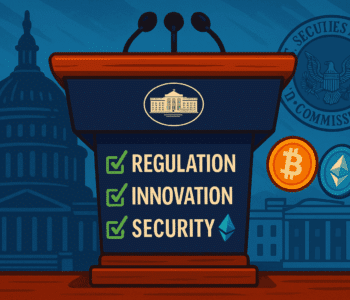
White House Releases Comprehensive Crypto Regulation Blueprint
The White House has unveiled a detailed roadmap for crypto policy that aims to streamline regulation and promote innovation within the industry.
The White House has released a 160-page roadmap outlining its plans for regulating crypto going forward. The document consolidates insights from major agencies including the Treasury, SEC, and CFTC, and is regarded as the most comprehensive federal policy guide for digital assets, aiming to establish clear rules while encouraging innovation.
Coordinated Action Replaces Scattered Responses
This roadmap builds on a previous executive order from 2022 but extends efforts for coordination on critical areas, including staking, token classification, stablecoin oversight, and DeFi monitoring, transforming how crypto is addressed at the federal level.
US WHITE HOUSE CRYPTO REPORT HAS BEEN RELEASED.
CROSS BORDER PAYMENT = XRP
US does NOT need Bitcoin, they need XRP. pic.twitter.com/UuruC77qTL
— {x} (@unknowDLT) July 30, 2025
Defining What Crypto Is and How It’s Treated
One of the goals of the roadmap is to clarify how regulators define crypto assets, including when tokens are classified as securities or commodities, and what is required for platforms in terms of registration. It also addresses potential tax reform concerning staking and mining activities. Special attention is given to stablecoins under the GENIUS Act, advocating for a unified regulatory framework nationwide.
Consumer Protection Is a Clear Priority
The recent collapses of major crypto firms have influenced this roadmap, prompting agencies to intensify enforcement against scams and risky practices in custody. Additionally, there will be educational programs aimed at enhancing public understanding of the risks associated with crypto.
Market Stability and Money Laundering Top the List
Concerns about systemic risk are acknowledged in the report, with a focus on improving supervision of stablecoins and DeFi tools that could impact traditional markets. The plan emphasizes better information sharing among agencies and strengthening anti-money laundering measures.
Support for Innovation, but With Guardrails
In contrast to prior restrictive approaches, the roadmap encourages crypto companies to thrive, allowing them to explore blockchain applications that can enhance financial infrastructure. While a national digital currency is still under evaluation, the message is clear: the industry can innovate safely.
No Updates on the Federal Crypto Reserve Plan
Notably absent from this roadmap is the idea of establishing a strategic reserve of Bitcoin and other digital assets, which leaves questions about the government’s long-term objectives in the crypto sector.
Congress Still Holds the Keys
While some proposals can be acted upon by regulators immediately, crucial elements like stablecoin laws and asset classification require Congressional legislative action. Currently, there is no definitive timeline for when these laws might be enacted.
A Pivotal Moment for U.S. Crypto Policy
This roadmap marks a significant development in crypto regulation, aiming for a framework that allows the industry to operate within definitive legal boundaries. The effectiveness of these measures will depend on how swiftly agencies and lawmakers respond to the guidelines.



